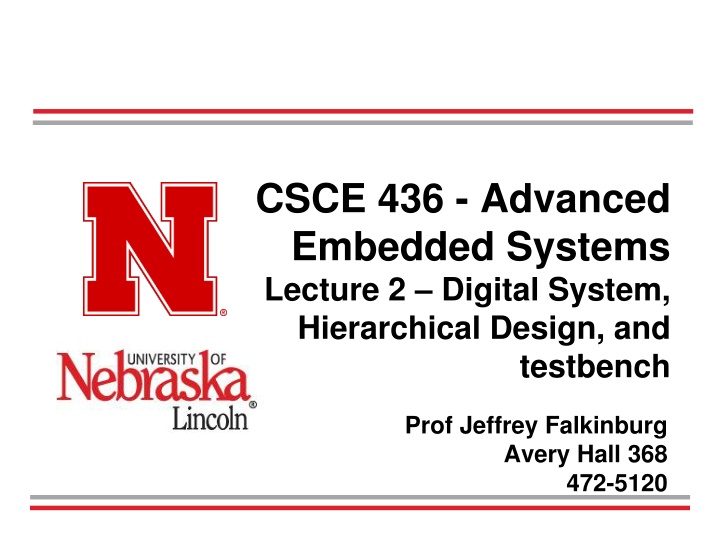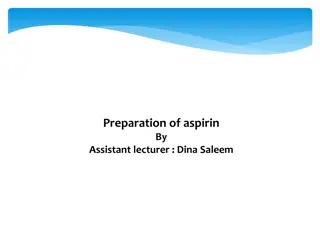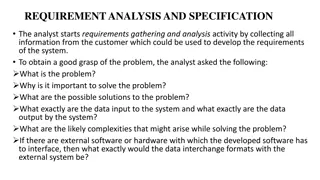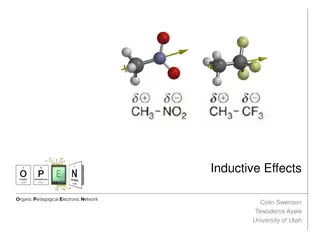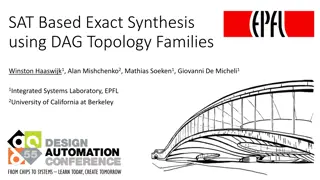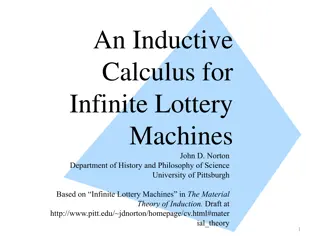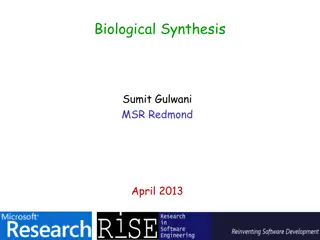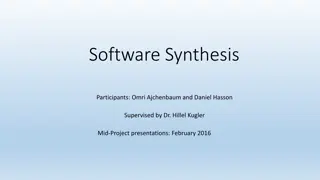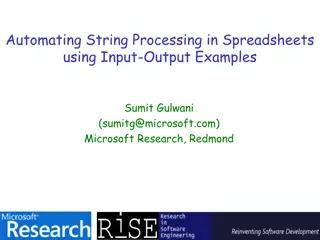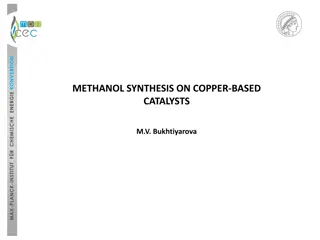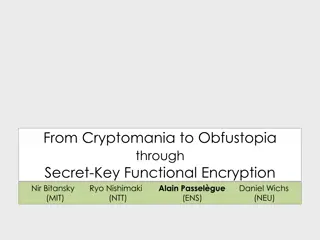Functional Synthesis: Moving Beyond Inductive Approach
Delve into the complex realm of functional synthesis, exploring approaches to ensuring correctness and addressing key questions of specification formalisms. Discover how multimodal synthesis offers a comprehensive solution to constraints in behavior.
Download Presentation

Please find below an Image/Link to download the presentation.
The content on the website is provided AS IS for your information and personal use only. It may not be sold, licensed, or shared on other websites without obtaining consent from the author.If you encounter any issues during the download, it is possible that the publisher has removed the file from their server.
You are allowed to download the files provided on this website for personal or commercial use, subject to the condition that they are used lawfully. All files are the property of their respective owners.
The content on the website is provided AS IS for your information and personal use only. It may not be sold, licensed, or shared on other websites without obtaining consent from the author.
E N D
Presentation Transcript
CSCE 436 - Advanced Embedded Systems Lecture 2 Digital System, Hierarchical Design, and testbench Prof Jeffrey Falkinburg Avery Hall 368 472-5120
Lesson Outline Time Logs! HW #1 Due Now! 1. Overview of HDLs 2. Basic VHDL concepts by example 3. Testbenches 2 CSCE 436 Advanced Embedded Systems
Overview of HDLs 3 CSCE 436 Advanced Embedded Systems
Programming Language Can we use C or Java as an HDL? A computer programming language: Semantics ("meaning") Syntax ("grammar") Development of a Language Study the characteristics of the underlying processes Develop syntactic constructs and their associated semantics to model and express these characteristics 4 CSCE 436 Advanced Embedded Systems
HDL vs Traditional PL Traditional PL Modeled after a sequential process Operations performed in a sequential order Help human's thinking process to develop an algorithm step-by-step Resemble the operation of a basic computer model HDL Characteristics of digital hardware Connections of parts Concurrent operations Concept of propagation delay and timing Characteristics cannot be captured by traditional PLs Require new languages: HDL 5 CSCE 436 Advanced Embedded Systems
HDL vs Traditional PL HDL continued Structural Connections Timing Parallel Nature 6 CSCE 436 Advanced Embedded Systems
Modern Use of HDLs Formal Documentation Input to a simulator Input to a synthesizer 7 CSCE 436 Advanced Embedded Systems
7400-Series Integrated Circuits 7400-Series Integrated Circuits https://en.wikipedia.org/wiki/List_of_7400- series_integrated_circuits Images from https://www.electronics-tutorials.ws/logic/logic_2.html 8 CSCE 436 Advanced Embedded Systems 3 March 2025
Characteristics of an HDL Capture characteristics of a digital circuit: Entity - basic building block (e.g. 7400 chips) Connectivity - Connection of entities (e.g. wires) Concurrency - parallel operations Timing - schedule / order of multiple operations Must be able to describe a circuit in Gate level and RT level Structural view and behavioral view (not physical) 9 CSCE 436 Advanced Embedded Systems
Highlights of Modern HDLs Encapsulate the concepts of entity, connectivity, concurrency, and timing Incorporate propagation delay and timing information Consist of constructs for structural implementation Incorporate constructs for behavioral description (sequential execution of traditional PL) Describe the operations and structures in gate level and RT level Consist of constructs to support hierarchical design process 10 CSCE 436 Advanced Embedded Systems
Industry-Standard HDLs VHDL DoD initiative in 1980s Transferred to IEEE to standardize First released in 1987 Similar to Ada Heavily used in FPGA industry New versions: 1993, 2001, 2008 Verilog Developed by industry Released in early 1980s Similar to C Heavily used in ASIC industry New versions: 1995, 2001, 2005, 2009 SystemVerilog is a superset of Verilog 2005 & 2009 11 CSCE 436 Advanced Embedded Systems
Basic VHDL Concepts By Example 12 CSCE 436 Advanced Embedded Systems
Structural Description Structural Description from Lesson 1 Entity Architecture Truth Table a b c | f -------|-- 0 0 0 | 0 0 0 1 | 0 0 1 0 | 0 0 1 1 | 1 1 0 0 | 0 1 0 1 | 1 1 1 0 | 1 1 1 1 | 1 13 CSCE 436 Advanced Embedded Systems
Structural Description Entity declaration i/o ports ( outline of the circuit) Architecture body Signal declaration Each concurrent statement Can be thought of as a circuit part Contains timing information Arch body can be thought as a collection of parts What s the difference between this and a C program 14 CSCE 436 Advanced Embedded Systems 3 March 2025
Structural Description In structural view, a circuit is constructed by smaller parts. Structural description specifies the types of parts and connections. Essentially a textual description of a schematic Done by using component in VHDL First declared (make known) Then instantiated (used) 15 CSCE 436 Advanced Embedded Systems 3 March 2025
Structural Description Component Declaration library IEEE; use IEEE.std_logic_1164.all; library unisim; use unisim.vcomponents.all; -- These lines are similar to a #include in C -- Use these libraries if you are using primitive components Primitive Components Library entity majority is end majority; port( a, b, c: f: in std_logic; out std_logic); Component Declarations before Begin architecture structure of majority is component AND2 port ( i0, i1 : in std_logic; end component; component OR3 port ( i0, i1, i2 end component; signal s1, s2, s3: std_logic; o : out std_logic); : in std_logic; o : out std_logic); -- wires which begin and end in the component 16 CSCE 436 Advanced Embedded Systems 3 March 2025
Structural Description Component Instantiation begin end structure; unit1: port map ( unit2: port map ( unit3: port map ( unit4: port map ( AND2 Component Instantiations -- s1 <= a and b; i0 => a, i1 => b, o => s1); AND2 after Begin -- s2 <= b and c; i0 => b, i1 => c, o => s2); AND2 -- s3 <= a and c; i0 => a, i1 => c, o => s3); OR3 -- f <= s1 or s2 or s3; i0 => s1, i1 => s2, i2 => s3, o => f); 17 CSCE 436 Advanced Embedded Systems 3 March 2025
Behavioral A behavioral description of a component describes what the circuit does rather than how it is done. library IEEE; -- These lines are similar to a #include in C use IEEE.std_logic_1164.all; entity majority is port( a, b, c: in std_logic; f: out std_logic); end majority; architecture Behavioral of majority is begin f <= '0' when a='0' and b='0' and c='0' else '0' when a='0' and b='0' and c='1' else '0' when a='0' and b='1' and c='0' else '1' when a='0' and b='1' and c='1' else '0' when a='1' and b='0' and c='0' else '1' when a='1' and b='0' and c='1' else '1' when a='1' and b='1' and c='0' else '1'; -- essentially an enumeration of a truth table end Behavioral; Truth Table a b c | f -------|-- 0 0 0 | 0 0 0 1 | 0 0 1 0 | 0 0 1 1 | 1 1 0 0 | 0 1 0 1 | 1 1 1 0 | 1 1 1 1 | 1 18 CSCE 436 Advanced Embedded Systems
Behavioral Concatenation operator helps make code more readable library IEEE; -- These lines are similar to a #include in C use IEEE.std_logic_1164.all; entity majority is port( a, b, c: in std_logic; f: out std_logic); end majority; architecture Behavioral of majority2 is signal temp: std_logic_vector(2 downto 0); begin temp <= a & b & c; f <= '0' when temp = "000" else '0' when temp = "001" else '0' when temp = "010" else '1' when temp = "011" else '0' when temp = "100" else '1' when temp = "101" else '1' when temp = "110" else '1'; end Behavioral; Concatenation Operator Double quotes for std_logic_vectors 19 CSCE 436 Advanced Embedded Systems
Combinational vs Sequential What is the difference between combinational and sequential? A clock signal in the entity for the output 20 CSCE 436 Advanced Embedded Systems
Literals In VHDL they are called literals (not a constant) hexDigit : std_logic_vector (3 downto 0); hexDigit = x D else hexDigit = 0101 else hexDigit = d 12 else = used to compare <= used to assign hexDigit : std_logic_vector (15 downto 0); hexDigit <= x C0_FF_EE ; --can also use separators 21 CSCE 436 Advanced Embedded Systems
Testbenches 22 CSCE 436 Advanced Embedded Systems
Testbench Component Declaration and Instantiation ENTITY majority_tb IS END majority_tb; ARCHITECTURE behavior OF majority_tb IS COMPONENT majority PORT( a : IN std_logic; b : IN std_logic; c : IN std_logic; f : OUT std_logic); END COMPONENT; signal s1, s2, s3, s4: std_logic; begin uut: majority PORT MAP ( a => s1, b => s2, c => s3, f => s4); end 23 CSCE 436 Advanced Embedded Systems 3 March 2025
Simple Test Vectors begin uut: majority PORT MAP ( a => s1, b => s2, c => s3, f => s4); end s1 <= '0', '1' after 40us; s2 <= '0', '1' after 20us, '0' after 40us, '1' after 60us; s3 <= '0', '1' after 10us, '0' after 20us, '1' after 30us , '0' after 40us, '1' after 50us , '0' after 60us, '1' after 70us, ; end behavior; 24 CSCE 436 Advanced Embedded Systems 3 March 2025
Testbench Test Vectors for self checking testbenches Test Vector Setup (before begin): 1. CONSTANT TEST_ELEMENTS:integer:=8; 2. SUBTYPE INPUT is std_logic_vector(2 downto 0); 3. TYPE TEST_INPUT_VECTOR is array (1 to TEST_ELEMENTS) of INPUT; 4. SIGNAL TEST_INPUT: TEST_INPUT_VECTOR := ("000", "001", "010", "011", "100", "101", "110", "111"); Loop to apply the 8 test input vectors to majority circuit (after begin) 1. for i in 1 to TEST_ELEMENTS loop 2. testVector <= test_input(i); 3. wait for 1 us; 4. assert f = test_output(i) 5. report "Error in majority circuit for input " & integer'image(i) 6. severity failure; 7. end loop; 25 CSCE 436 Advanced Embedded Systems 3 March 2025
Testbench Test Vectors for self checking testbenches Test Vector Setup: 1. CONSTANT TEST_ELEMENTS:integer:=8; 2. SUBTYPE INPUT is std_logic_vector(2 downto 0); 3. TYPE TEST_INPUT_VECTOR is array (1 to TEST_ELEMENTS) of INPUT; 4. SIGNAL TEST_INPUT: TEST_INPUT_VECTOR := ("000", "001", "010", "011", "100", "101", "110", "111"); Loop to apply the 8 test input vectors to majority circuit 1. for i in 1 to TEST_ELEMENTS loop 2. testVector <= test_input(i); 3. wait for 1 us; 4. assert f = test_output(i) 5. report "Error in majority circuit for input " & integer'image(i) 6. severity failure; 7. end loop; 26 CSCE 436 Advanced Embedded Systems 3 March 2025
Simulation Experimentation How to add and remove waveforms to the waveform view. How to change the radix of a vector waveform How to change the colors of the waveforms. How to transcend the design hierarchy. How to observe signal values in design hierarchy. How to observe signals values in the VHDL code. How to save a load a simulation waveform wcfg file. 27 CSCE 436 Advanced Embedded Systems
Lesson Outline 1. Overview of HDLs 2. Basic VHDL concepts by example 3. Testbenches 32 CSCE 436 Advanced Embedded Systems
